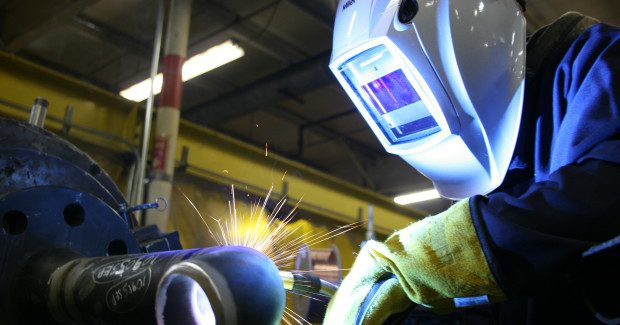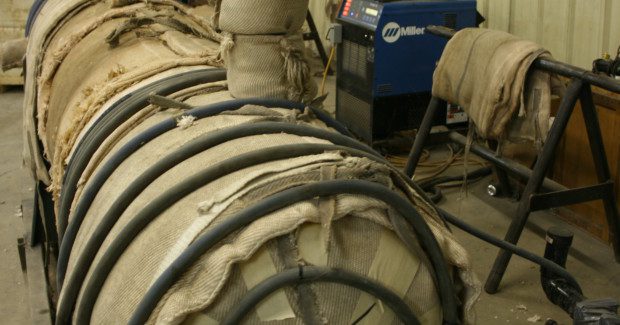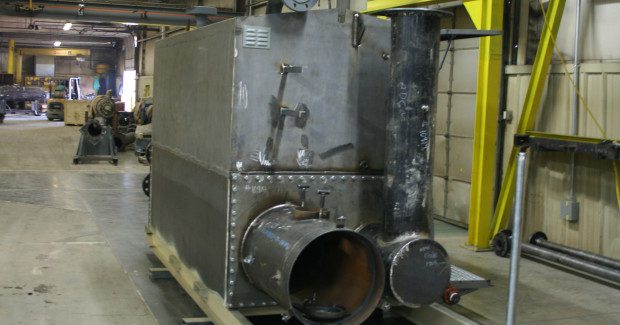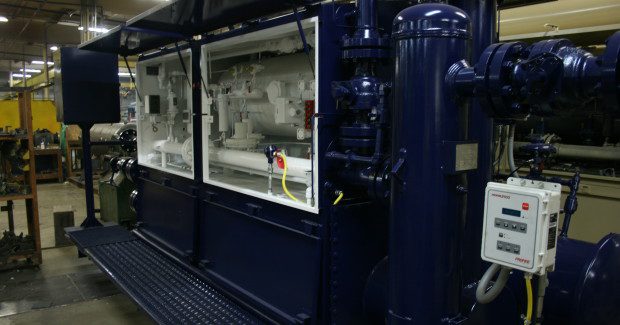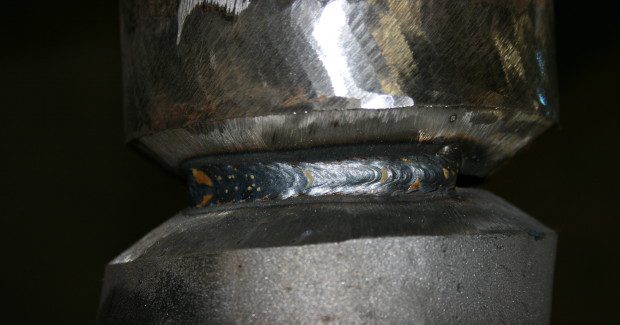The Pride of the Pipeline
By changing welding processes, this oil and gas production equipment manufacturer cut more than 200 man-hours out of each product to thrive during the shale gas boom.
Posted: May 30, 2014
Pride of the Hills Manufacturing, Inc. (Big Prairie, OH) is largely sustained by what sits hundreds and thousands of feet beneath those hills: shale gas. Set in the heart of Marcellus and Utica Shale country, Pride of the Hills has grown with the region’s shale gas production boom. As a manufacturer of oil and gas production equipment, the company has grown and evolved with increased production levels, locally and nationwide.
There was once a time when a great shale well in the area produced 100,000 cu ft of natural gas per day. A good shale well now produces 60 million cu ft per day. Pride of the Hills has responded in kind, moving from smaller, low-pressure equipment to the larger, higher pressure systems it now takes to operate a shale gas well.
With increasing production comes an expedited demand for Pride of the Hills’ products: production equipment that sits at the head of the well and separates the oil, gas and water and turns it into a saleable product. These systems are complicated networks of pressure vessels and high-pressure piping.
To meet that demand, the company has taken welding processes that are conventional by industry standards (TIG root, Stick hot and cover passes) and changed them to solid wire MIG applications (Regulated Metal Deposition (RMD™) and Pulsed MIG) to significantly increase production and meet customer demand. On a micro scale, that means taking a two-hour welding process down to 20 minutes and reducing test failure rates on its sand separators down to almost zero. On a macro scale, it means producing an entire system from scratch in the time it previously took just to do the welding.
“We’ve been able to reduce our man hours to produce that same product at the same high quality by using newer technology in a controlled environment, and have that accepted by people that have some real stringent standards,” says Curt Murray Jr., the vice president of Pride of the Hills Manufacturing and the president/founder of Grace Automation.
HIGH PRESSURES AT THE HEAD OF THE WELL
The gas stream that comes out of a shale gas well does so at between 3,000 lb and 6,000 lb of pressure. That stream then goes through a sand separator rated between 5,000 lb and 6,000 lb that allows the solids to settle out of the oil, water and gas stream. That stream is then depressurized, which causes rapid cooling, dropping in temperature by as much as 150 deg. That stream is then reheated and brought back through the separator, removing the fluids and sending the natural gas down the line. Pride of the Hills also designs systems that can take the bulk liquid remains and turn the oil into a stable, saleable product.
“Our challenges are that we’re dealing with high pressures, high volumes of dirty product that we have to clean, regulate, produce safely, monitor and put down into a sales line into a place where it can be used for your home or my factory or trucked off someplace.”
DEALING WITH THE PRESSURE
Pride of the Hills’ products are extensively regulated due to the volatility of the oil and gas extraction process. Piping is typically constructed of an A/SA106 grade B or grade C carbon steel, while pressure vessels are typically built of SA516 grade 70 material. The company’s work is regulated under codes from the American Petroleum Institute (API – numerous) and the American Society of Mechanical Engineers (ASME – B31.3), as well as the strict requirements of each customer. All welding processes must be tested and proven to meet the quality of each code.
Murray recounts the recent process with one of his primary customers, Shell, in examining ways to shorten product lead times without actually expanding his facilities (although the company is also physically expanding as well). Much of the work performed required conventional methods: TIG welding in the root pass and then performing follow-up passes with Stick welding. What Murray and his team proposed was performing root passes with the RMD process and then transitioning to a Pulsed MIG process on the remaining passes.
“We had to weld test coupons, pull tensiles, acid etch it and such to prove to them that it was as high a quality weld as what they were getting with the (previous processes),” says Murray. “And it wasn’t without challenges because a large company would just as well stay with the standards that they were comfortable with. But because of their need for equipment and their delivery times, we were able to convince them that we can do it in another process that will give you the quality that you need to feel safe, but we can also meet your timelines.”
Tests proved to Shell that these new processes met their quality requirements and would help significantly shorten lead times on the products they needed from Pride of the Hills.
“When you start looking at the mechanicals of a weld,” says Murray, “it has very much to do with the strength of the material you’re welding with, so when we compare a similar wire to a similar rod, the mechanicals are going to be very similar. So even though we’re going to be depositing them a little differently, inevitably the mechanicals end up very similar. So the quality of the weld, the mechanics of the weld and everything looked very similar to what their expectations were (compared to other types of metal transfer).”
THE EVOLUTION OF WELDING PROCESSES
Pride of the Hills moved forward and replaced TIG welding of the root with RMD, relying on the Miller PipeWorx Welding System as its primary welding power source. RMD is a modified short-circuit MIG process where the welding system anticipates and controls the short circuit, then reduces welding current to create a consistent metal transfer.
Precisely controlled metal transfer provides uniform droplet deposition, making it easier for the welder to control the puddle. The smooth metal transfer also compensates for high-low misalignment between pipe sections and creates more consistent root reinforcement on the inside of the pipe (than other short-circuit MIG processes). The process also maintains a consistent arc length regardless of electrode stick-out. It compensates for operators that have problems holding a constant stick-out, and it enables a better view of the weld puddle – making the process much easier to learn than TIG welding.
“When you start TIG welding,” says Murray, “your deposition rates are desperately low. It’s a great weld, but we’re hand feeding one drop of metal at a time into the root pass. It also takes a highly skilled person to do that . . . now, instead of manually feeding a filler metal, it’s being fed automatically by the machine. Now, instead of us using a foot pedal to control the heat, we have a truly adaptive (power source) that, as we change our tip-to-work distance or we move around a little bit like we do as humans, the (power source) is automatically adjusting to those changes for us.”
For fill and cap passes, the company has transitioned from Stick welding to Pulsed MIG welding. Pulsed MIG provides easy puddle control for both in-position and out-of-position welding, helping to reduce training time. The process also improves fusion and fill at the toe of the weld, which leads to faster travel speeds and higher deposition rates. Less heat input also reduces interpass cooling time, which improves weld cycle times and helps retain the mechanical properties of the pipe.
“It allows us to actually put in a higher deposition rate then we can with the Stick,” says Murray. “And at the end of that pass, your Stick welder is going to have to stop, he’s going to have to chip off the slag that he just placed, he’s going to have to back grind that weld to get it clean and prepped to put the next weld on top of it. Where our welder today uses a pulse spray, he may have a little bit of a silicon puddle or a little bit of impurity on the top that he can just run a wire wheel on, so it’s really a quick clean-up.”
Both processes have also allowed the company to standardize largely on one wire type (ER70S-6) and one gas type (90 percent argon/10 percent CO2), further simplifying inventory and training. The company has even outfitted a robotic cell with a Miller Auto-Access® system capable of performing both processes. Murray believes RMD and Pulsed MIG welding have helped spur productivity quantifiable improvements.
“We’re able to bring it into the shop, get it into a controlled environment where we can use a hard wire gas-shielded process and provide just as high quality of weld because we are in the controlled environment,” says Murray. “And we can take that hour-and-a-half or two hour process (on one joint) and reduce it using a hand-held mechanized welder to something around 20 minutes. And then we also can take (another) step there and put it over on our robot using similar welding processes and take it down to 10 or 15 minutes.”

